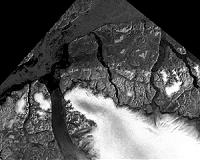 |
New York NY (SPX) Mar 25, 2011 Conservationists from the Wildlife Conservation Society, the American Museum of Natural History, and other conservation and research groups have discovered that groups of dolphins in the western Indian Ocean do not mix freely with one another. In fact, dolphin populations are kept separate by currents and other unseen factors. Specifically, the researchers have found that genetically distinct populations of the Indo-Pacific humpback dolphin may be formed in part by currents, surface temperature differences, and other environmental barriers, a finding made possible by using both genetic data from dolphins and environmental information from remote-sensing satellites. The study appears in the advance online version of the journal Heredity. The study authors are: Martin Mendez of the American Museum of Natural History and the Wildlife Conservation Society; Ajit Subramaniam of Columbia University; Tim Collins of the Wildlife Conservation Society and the Environment Society of Oman; Gianna Minton of the Environment Society of Oman and the Institute of Biodiversity and Environmental Conservation, University Malaysia Sarawak; Robert Baldwin of the Environment Society of Oman; Per Berggren of Newcastle University; Anna Sarnblad of Stockholm University; Omar A. Amir of the Institute of Marine Sciences, University of Dar es Salaam; Victor M. Peddemors of the University of KwaZulu-Natal and the Cronulla Fisheries Research Centre; Leszek Karczmarski of the University of Hong Kong; Almeida Guissamulo of Universidade Eduardo Mondlane, Museu de Historia Natural; and Howard C. Rosenbaum of the Wildlife Conservation Society. The study represents a breakthrough in high-tech research on marine wildlife and a foundation for ensuring sound future management decisions on the Indo-Pacific humpback dolphin, a distant relative of the more familiar bottlenose dolphin. It is one of the first examinations of how environmental factors in marine environments can influence population structure in marine species, and can potentially enhance an understanding about the environmental factors that may drive the evolution of new species. "Examining how environmental factors affect the population structure of marine species is a complex task. Doing this over entire regions is a challenge," said lead author Dr. Martin Mendez of the Sackler Institute for Comparative Genomics at the American Museum of Natural History. "Unlike studies of terrestrial species in easily observable environments, marine species are difficult to follow and the barriers they encounter are often invisible to us. Molecular technologies and remote sensing data can be combined to shed light on these mysteries." The team started its examination of Indo-Pacific humpback dolphin populations using genetics, analyzing mitochondrial DNA data from more than 90 individual dolphins from the coastal areas of Oman, Mozambique, Madagascar, Tanzania, and South Africa. The scientists used this "genetic marker" to statistically measure gene flow between dolphin groups at different locations. The researchers then compared their molecular findings with 13 years of data from NASA's satellites on environmental factors such as currents, temperature, turbidity, levels of chlorophyll, and dissolved organic matter. Dr. Mendez and his co-authors have succeeded in finding support for the hypothesis that environmental differences between regions could influence the population structure of marine species. Specifically, they found correlations between regional environmental differences and measurable genetic breaks between populations of dolphins from Mozambique and Tanzania in Africa, and Oman on the Saudi Arabian peninsula. On the largest regional scale, data on currents seem to correlate with genetic distinctiveness between certain populations. In particular, the South Equatorial Current-which runs west across the Indian Ocean before diverging north and south as it meets the African continent-seems to represent a barrier between genetically distinct populations of Mozambique and Tanzania; the current may play a role in creating them. Seasonal monsoons also potentially contribute to what researchers found was a lack of southbound migration (or detectable gene flow) along the African coast. The researchers also found agreement on smaller spatial scales. Differences in temperature, chlorophyll, turbidity, and dissolved organic matter between regions also coincided with genetic differences between dolphin populations in Mozambique, Tanzania, and Oman. The two coastal regions without detectable genetic distinctiveness between dolphin populations-Mozambique and South Africa-also lacked significant environmental differentiation between them, a finding in agreement with the correlation of both genetic and environmental differences detected in other areas. "With increasing development and potential threats to coastal habitats, understanding the population structure of the Indo-Pacific humpback dolphin in conjunction with environmental factors is an important step in formulating management recommendations and protection measures for the species," said Dr. Howard Rosenbaum, Director of the Wildlife Conservation Society's Ocean Giants Program.
Share This Article With Planet Earth
Related Links Wildlife Conservation Society Earth Observation News - Suppiliers, Technology and Application
 Measurements Of Winter Arctic Sea Ice Shows Continuing Ice Loss
Measurements Of Winter Arctic Sea Ice Shows Continuing Ice LossBoulder CO (SPX) Mar 25, 2011 The 2011 Arctic sea ice extent maximum that marks the beginning of the melt season appears to be tied for the lowest ever measured by satellites, say scientists at the University of Colorado Boulder's National Snow and Ice Data Center. The CU-Boulder research team believes the lowest annual maximum ice extent of 5,650,000 square miles occurred on March 7. The maximum ice extent was 463,000 ... read more |
|
| The content herein, unless otherwise known to be public domain, are Copyright 1995-2010 - SpaceDaily. AFP and UPI Wire Stories are copyright Agence France-Presse and United Press International. ESA Portal Reports are copyright European Space Agency. All NASA sourced material is public domain. Additional copyrights may apply in whole or part to other bona fide parties. Advertising does not imply endorsement,agreement or approval of any opinions, statements or information provided by SpaceDaily on any Web page published or hosted by SpaceDaily. Privacy Statement |